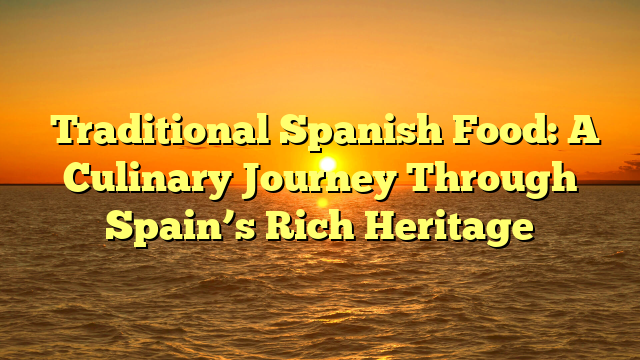
Spain is known for its vibrant culture, historical landmarks, and, most importantly, its rich and diverse cuisine. Traditional Spanish food is deeply rooted in history, shaped by the influences of various civilizations, including the Romans, Moors, and indigenous Iberians. Each region in Spain has its unique flavors and signature dishes, making Spanish cuisine one of the most diverse in the world. This article explores the significance of traditional Spanish food, its role in preserving heritage, and some of the most iconic dishes that define Spain’s culinary landscape.
The Importance of Traditional Spanish Food
Traditional Spanish food is an essential part of the country’s identity. It reflects Spain’s geography, climate, and cultural influences. From the seafood-rich dishes of coastal regions to the hearty stews of inland areas, Spanish cuisine is a testament to the diversity of the land and its people.
samosir88 login in Spain is more than just sustenance—it is a way of life. Spanish meals are often social events, bringing family and friends together to enjoy long, leisurely dining experiences. Tapas culture, where small plates of food are shared, embodies this communal spirit and fosters social interaction.
Moreover, Spanish food plays a significant role in celebrations and festivals. Each region has its traditional dishes associated with local fiestas. For instance, during La Tomatina festival in Buñol, people celebrate with an abundance of tomatoes, while in Seville, Feria de Abril is accompanied by tapas, jamón, and refreshing glasses of sherry.
Regional Diversity in Spanish Cuisine
Spain’s diverse landscapes and climates contribute to its regional culinary variations. The north, including Galicia and the Basque Country, is known for fresh seafood and hearty stews, while the south, particularly Andalusia, is famous for its Moorish-influenced dishes like gazpacho and fried fish. The central regions, such as Castile, offer robust meat-based dishes, and the Mediterranean coast is renowned for its olive oil-based cuisine and fresh vegetables.
Iconic Traditional Spanish Dishes
Spain boasts an array of traditional dishes that have stood the test of time. Here are some of the most iconic Spanish foods:
1. Paella
Paella is one of Spain’s most famous dishes, originating from Valencia. This rice-based dish is cooked with saffron and a variety of proteins such as seafood, chicken, or rabbit. Paella showcases the Mediterranean influence on Spanish cuisine and is a must-try for visitors.
2. Gazpacho
A refreshing cold tomato soup, gazpacho originates from Andalusia. Made with ripe tomatoes, cucumbers, bell peppers, garlic, olive oil, and vinegar, this dish is particularly popular during the hot summer months.
3. Jamón Ibérico
Spain is world-famous for its cured ham, particularly Jamón Ibérico. This delicacy is made from black Iberian pigs and aged for several years, resulting in a rich, savory flavor. It is often enjoyed on its own or paired with cheese and wine.
4. Tortilla Española
Tortilla Española, or Spanish omelet, is a simple yet delicious dish made with eggs, potatoes, and onions. It is a staple in Spanish households and is commonly served as a tapa.
5. Churros con Chocolate
A favorite Spanish treat, churros are fried dough pastries often enjoyed with thick, rich hot chocolate for dipping. They are commonly eaten for breakfast or as an afternoon snack.
6. Patatas Bravas
Patatas Bravas is a popular tapa consisting of crispy fried potatoes topped with a spicy tomato sauce and aioli. This dish is a staple in Spanish bars and restaurants.
7. Pulpo a la Gallega
Hailing from Galicia, Pulpo a la Gallega (Galician-style octopus) is a traditional dish where octopus is boiled, sliced, and seasoned with paprika, olive oil, and sea salt. It is often served on wooden plates with a side of potatoes.
8. Fabada Asturiana
A hearty bean stew from Asturias, Fabada Asturiana is made with white beans, chorizo, morcilla (blood sausage), and pork. It is a comforting dish typically enjoyed in colder months.
9. Pisto
Similar to ratatouille, Pisto is a vegetable-based dish made with tomatoes, peppers, zucchini, and onions, all slowly cooked in olive oil. It is often served with a fried egg on top.
10. Bacalao al Pil-Pil
A Basque specialty, Bacalao al Pil-Pil features salted cod cooked in a sauce made from olive oil, garlic, and chili peppers. The sauce emulsifies naturally, creating a unique and flavorful dish.
Traditional Spanish Drinks
No discussion of Spanish food is complete without mentioning the country’s traditional beverages. Spain is known for its excellent wines, including Rioja and Cava. Other notable drinks include:
● Sangria – A refreshing mix of red wine, fruit, brandy, and soda.
● Horchata – A sweet, nutty drink made from tiger nuts, popular in Valencia.
● Sherry – A fortified wine from Andalusia, ranging from dry to sweet varieties.
The Role of Traditional Spanish Food in Modern Society
Despite the increasing influence of globalized cuisine, traditional Spanish food remains at the heart of the country’s culinary identity. Many chefs are reviving ancient recipes, incorporating modern techniques while preserving authenticity. Michelin-starred restaurants in Spain, such as El Celler de Can Roca and Arzak, honor traditional flavors while pushing culinary boundaries.
The farm-to-table movement in Spain also emphasizes the importance of fresh, local ingredients, much like traditional Spanish cooking. Farmers’ markets are still popular, where people buy high-quality, seasonal produce for home-cooked meals.
Additionally, Spanish cuisine has gained international recognition, with tapas bars and Spanish restaurants opening worldwide. This global appreciation ensures that traditional Spanish food remains relevant and continues to thrive beyond Spain’s borders.
Conclusion
Traditional Spanish food is a reflection of Spain’s rich history, diverse geography, and deep-rooted culinary traditions. From the world-famous paella to the comforting Fabada Asturiana, Spain’s cuisine offers a unique blend of flavors, ingredients, and cooking techniques that have been preserved for generations. As the world becomes increasingly interconnected, maintaining and celebrating traditional Spanish food helps preserve cultural identity while allowing future generations to appreciate and enjoy Spain’s remarkable culinary heritage.





